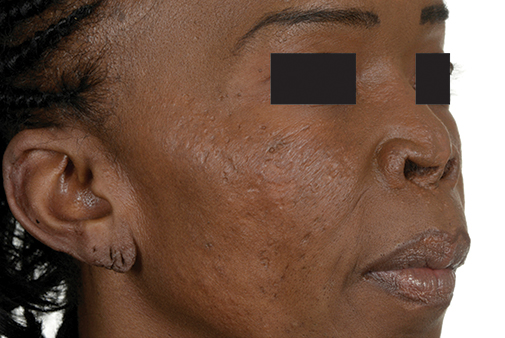Translate this page into:
Facial Cutaneous Sarcoid Treated Successfully with Carbon Dioxide Laser in Skin Type 6
Address for correspondence: Dr. Firas Al-Niaimi, 152 Harley Street, London, UK. E-mail: firas55@hotmail.com
This is an open access article distributed under the terms of the Creative Commons Attribution-NonCommercial-ShareAlike 3.0 License, which allows others to remix, tweak, and build upon the work non-commercially, as long as the author is credited and the new creations are licensed under the identical terms.
This article was originally published by Medknow Publications & Media Pvt Ltd and was migrated to Scientific Scholar after the change of Publisher.
Sarcoidosis is a granulomatous disease which can affect the skin primarily or as part of a multisystem organ involvement.[1] Lesions can be classified by their clinical morphology, for example, erythematous, erythematopapular, papular, nodular, erythrodermic, ulcerative, psoriasiform, and plaque sarcoid (lupus pernio); by their pathogenesis, for example, scar and tattoo sarcoid; or according to anatomic site, for example, palmoplantar, periungual, and mucosal.[1] Treatment can be topical or systemic, the latter particularly in systemic involvement or disseminated cutaneous lesions refractory to topical therapy.[2]
A 55-year-old female with skin type 6 who had pulmonary and cutaneous sarcoidosis for many years was treated successfully with the carbon dioxide laser. Her systemic disease was under control following the use of systemic prednisolone. Her papulonodular cutaneous sarcoid component affected predominantly her cheeks which has led to severe psychological distress and has proven to be resistant to various topical treatments and systemic therapies including hydroxychloroquine [Figures 1–3].

- Front view before treatment

- Left cheek before treatment

- Right cheek before treatment
The patient underwent a total of two treatments under local anesthesia. The area was cleaned and treated with the UltraPulse device (Lumenis, Israel). The initial approach was to carefully ablate each papule or nodule with the Truespot (collimated 2 mm spot) using 10–15 W at 10 ms pulse duration followed by light superficial ablation to ‘blend in’ the entire treated area using the ActiveFX handpiece at 100–125 mj, computer-pattern-generator 1-5-3 with feathering at the edges using lower fluence and density. Posttreatment was provided with a petrolatum ointment to aid the reepithelialization process and appropriate antimicrobial treatment and the use of sun protection once complete wound healing has taken place [Figures 4–6].

- Front view post treatment

- Left cheek post treatment

- Right cheek post treatment
The patient has made an excellent recovery with no complications and remains in remission after 12 months of follow-up and is very pleased with her appearance. This case demonstrates the possible use of carbon dioxide laser in specific cases of cutaneous sarcoid and a higher skin type should not hinder its use. The use of lasers in the management of cutaneous sarcoid with lasers has been previously reported in the literature.[3]
REFERENCES
- Sarcoidosis (8th ed.). London: Wiley-Blackwell; 2010. Ch. 61
- The use of lasers in cutaneous sarcoid: Is there a role? J Cosmet Laser Ther. 2016;18:335-8.
- [Google Scholar]





